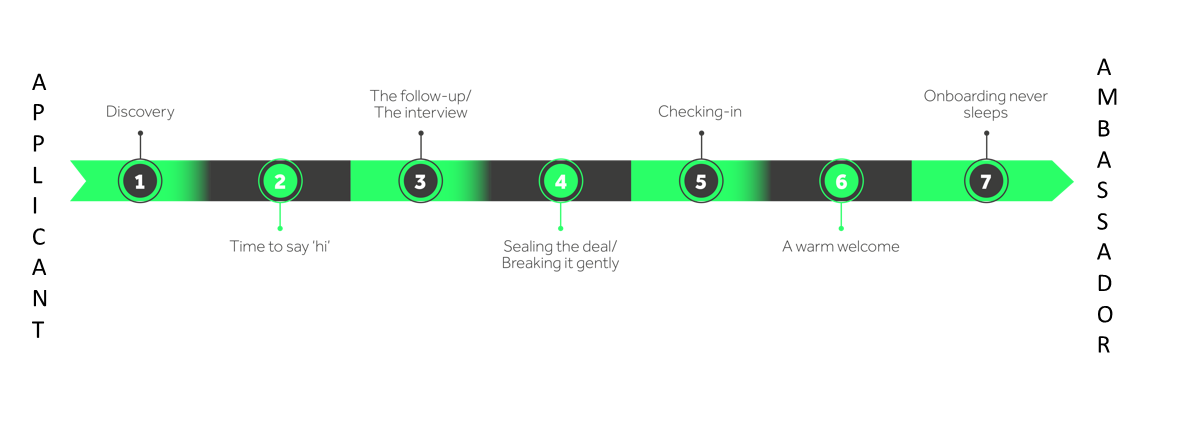Attraction / How to build an amazing moment-centric candidate experience

William Geldart
September 26, 2019
When it comes to enhancing your candidate experience it can be tempting to take the magpie approach. “Our competitors look amazing, therefore we need more shiny stuff!”
Sure, collateral is important. Slick creative, laser-focused messaging and a recruitment marketing budget that would make even the least cost-conscious CMO wince all sound desirable.
But unless you get the experience right all your best endeavours will be put in the shade.
To really attract the people you desire you’ve got to focus on the moments that matter.
In this blog I’m going to take a look at:
- Learnings from the customer experience
- Plotting the CX timeline
- The real game-changers
Some of what I’m about to put down isn’t new or revolutionary.
But it's still hyper-relevant, especially when you consider that ‘73% of job seekers say the process of looking for a job is one of the most stressful events in life’.
REALLY? It needn’t be this way.
Learnings from the customer experience
In a nutshell, an increasing number of brands have recognised the parallels between customer and candidate experience. And the benefits of ensuring both are exceptional.
He remarked: "At key moments along this journey, consumers are demonstrating their intent very clearly—in what have been dubbed 'micro-moments'—and these are the most compelling opportunities along the new journey path.”
The same can be said of the candidate journey. If we translate this thinking to the hiring process then we’ll find jobseekers with clear needs, as well as the desire to act on their intent.
The micro-moments that line the experience are key.
Edelman added: “A number of companies we work with are actually realigning themselves around journeys, physically changing their organization structure to a journey-management approach.”
The same methodology has been applied to the way we think about candidate experience. Your candidate journey, and the quality of the moments you create, will make or break whether you attract and retain the best people.
Plotting the CX timeline
Where does the candidate experience begin and where does it end?
For the purposes of this blog, I’m going to use the timeline we put forward in our Attraction Lab sessions (shameless plug but it is relevant, I promise).
We break it down like this:

Discovery
Research from Glassdoor revealed that on average candidates will use 12-18 touchpoints before deciding whether to apply for a role.
Therefore, it's important to deliver plenty of engaging, relevant content at the Discovery stage.
Your careers site, social channels (dedicate one to your employer brand) and job specs are three key touchpoints.
How can these be enhanced?
Do you feature enough rich media or stories from your people? What are you going to do about those poorly formatted, text-only job specs?
How about bringing a role to life with a video from the hiring manager?
These are common observations and they only scratch the surface. The point is, first impressions count.
And you might not get another moment to impress should your brand fail to engage its intended audience.
Time to say “hi”
This is where the user experience is so important.
For example, if someone has gone to the trouble of filling in a form or requesting more information then their next steps should be seamless.
In the age of automation, responding with a well-crafted candidate pack or a simple company overview needn’t be a time or cost-intensive process.
Neither is an internal recruiter picking-up the phone or typing out a personal email to introduce themselves.
The follow-up/The interview
Getting an in-demand candidate to interview is no mean feat. The best will want to know their time is not going to be wasted.
But going the extra mile to get to this stage needn’t involve any over-elaborate gestures.
Something as simple as sending a one-pager on ‘what to expect at interview’ or inviting a candidate in for a tour round the office will be appreciated.
Likewise, setting the right expectations and ensuring your feedback is quick and consistent is all powerful stuff.
Surveys are another key weapon that should be included in your CX arsenal.
Ask your candidates how they felt about the way the role was communicated to them or how prepared the interviewer was. Make your moments measurable.
Sealing the deal/Breaking it gently
This fork in the road shouldn’t be taken lightly.
Whether you’re sealing the deal or having to deliver bad news, experience is everything.
You’ve got to be ready to offer valuable feedback, whatever the outcome. And not just a copied and pasted response, a personal and specific communication that tells the candidate why they were the ideal fit or the reasons why their application was unsuccessful.
Again, a survey to measure experience, response time and the feedback given will provide vital information.
Checking-in
The offer’s been accepted but you’ve got to wait one, maybe more months until your new hire can walk through the door.
This can be a nervy time!
But not if engagement levels are kept high. One idea we trialled was to email across periodic countdown messages, just to let our impending starters know we were thinking about them.
A warm welcome
You’ve sold the dream, now comes the reality. Make sure the two match-up, otherwise your new hire could start to become disillusioned very quickly.
Getting off on the right foot is crucial.
So, when welcoming your new hire, get their manager to send a quick introduction email, or perhaps the team can record a quick welcome gif.
You could even send some company-branded stationery in the post before their first day.
However you do it, make sure your impending starter is made to feel welcome and valued.
Onboarding never sleeps
I won’t get into a debate about where candidate experience ends and employee experience begins.
But what I will say is you can’t afford to rest on your laurels just because you’ve made a hire.
Your new starter has made a life-changing decision so treat them and their choice with the respect it deserves. Check-in more regularly during their opening days, weeks and months into the role.
Find out what they like, what they’re not so keen on and how this matches up to their initial expectations. Another good idea is to assign a workplace buddy to help them settle in and to have more informal chats.
Likewise, as an HR team you should catch-up regularly to review your hiring and onboarding processes and share the feedback you’ve received.
The real game-changers
What’s really going to make the difference?
By no means do the following statements represent the ‘silver bullet’ in transforming CX.
But they should hopefully give some food for thought when considering how your candidate experience can be enhanced.
HR and marketing need to become best friends
Your HR team may have ultimate control and ownership of the candidate experience. But marketing can really help to bring this to life. And some.
Companies with strong HR-marketing collaboration will outperform their peers by taking advantage of this alignment. They'll work together to create and execute standout employer brand strategies, they'll develop consistent brand messaging and contribute to a more harmonised candidate experience, thus improving retention.
Not only that, these two core functions can also a lot from each other when it comes to defining process excellence and enhancing the candidate journey.
Candidate personas are key
Our guide to crafting and leading with candidate personas gives more detail. But in short, personas shouldn’t be viewed as merely a ‘nice to have’.
They should be used to properly profile roles, breed consistency in your hiring community and connect on a deeper level with candidates. Qualifications and experience are all well and good. But how about trying to understand where your ideal hires hang out, on and offline? Or more around their drivers and motivations?
Fuel the funnel with content journeys
Serving the right content at the right time is a well-used sales and marketing practice. And it should be no different for candidates than it is for prospects.
Sending out updates on live roles, useful interview tips and relevant company press releases that add value will keep your talent pool engaged and your business front of mind.
Don’t forget about the meet and greet
It might sound ridiculous, but you’d be surprised to know how frequently I hear of hiring managers not meeting and greeting their new team members. And I’m not just talking about on the first day, I’m referring to the first week in some cases.
Building talent communities isn’t the future, it’s now
Effective talent pooling isn’t keeping names in your database for a rainy day. It’s about building communities your candidates want to be a part of.
Marketing savvy recruitment agencies are jumping on this trend, building bespoke online destinations, hosting hackathons, meet-ups, keynote speeches and more.
All to keep candidates engaged and provide moments that stick in the memory.
Want to talk all things attraction and strategy? Drop me a message on LinkedIn or feel free to email william.geldart@bps-world.com to continue the conversation.


